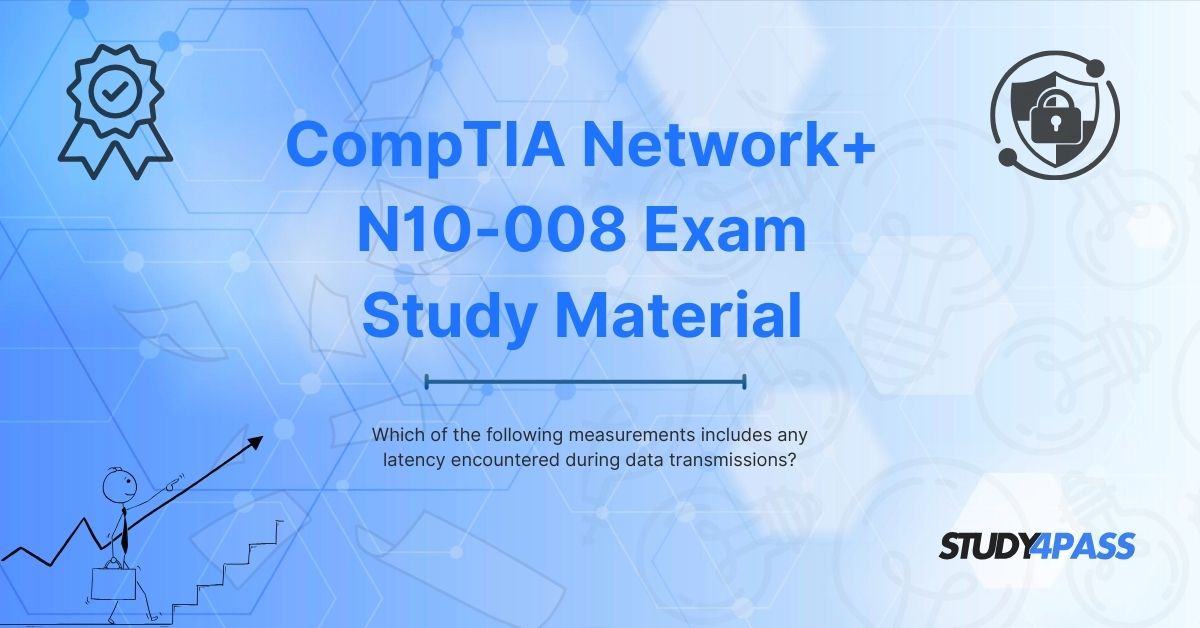Introduction
In the world of networking, understanding how data travels from one point to another is crucial. One of the most important aspects of data transmission is latency, which refers to the delay encountered during data transfer. For candidates preparing for the CompTIA Network+ (N10-008) exam, grasping latency-related measurements is essential.
This article explores the different measurements that include latency encountered during data transmissions, a key topic in the CompTIA Network+ certification. Additionally, we will discuss why Study4Pass is an excellent resource for mastering these concepts and passing the exam with confidence.
What is Latency in Networking?
Latency is the time it takes for a data packet to travel from its source to its destination. It is measured in milliseconds (ms) and can be influenced by various factors, including:
- Propagation delay (time taken for a signal to travel through a medium)
- Transmission delay (time taken to push all bits of a packet onto the network)
- Processing delay (time taken by routers/switches to process packet headers)
- Queuing delay (time spent in network device buffers before transmission)
High latency can negatively impact real-time applications like VoIP, video conferencing, and online gaming.
Measurements That Include Latency in Data Transmission
Several networking metrics account for latency. Below are the key measurements covered in the CompTIA Network+ N10-008 exam:
1. Round-Trip Time (RTT)
Definition: The total time taken for a signal to travel from the sender to the receiver and back.
How It Works:
- A device sends a packet (e.g., an ICMP Echo Request via ping).
- The destination responds (ICMP Echo Reply).
- The total time taken is the RTT.
Example:
ping example.com
Output:
Reply from example.com: bytes=32 time=45ms TTL=56
Here, 45ms is the RTT, which includes all latency factors.
Why It Matters for Network+:
- Helps diagnose network delays.
- Critical for performance tuning in TCP/IP networks.
Time to First Byte (TTFB)
Definition: The time taken for a client to receive the first byte of data after sending a request.
How It Works:
- A user requests a webpage.
- The server processes the request and sends the first data packet.
- TTFB includes DNS lookup, TCP handshake, and server processing time.
Example:
- A slow database query can increase TTFB.
- High TTFB indicates server-side or network latency.
Why It Matters for Network+:
- Important for web performance analysis.
- Helps identify server or network bottlenecks.
Jitter
Definition: The variation in latency over time.
How It Works:
- Inconsistent delays cause packets to arrive at irregular intervals.
- Measured in milliseconds (ms).
Example:
- VoIP calls may experience choppy audio due to high jitter.
Why It Matters for Network+:
- Affects real-time applications.
- Can be mitigated using Quality of Service (QoS).
Packet Delay Variation (PDV)
Definition: Similar to jitter, PDV measures fluctuations in packet arrival times.
How It Works:
- Critical for streaming and VoIP.
- High PDV leads to buffering and poor call quality.
Why It Matters for Network+:
- Helps in troubleshooting VoIP issues.
- Part of QoS optimization strategies.
End-to-End Delay
Definition: The total time taken for a packet to travel from source to destination.
Components:
- Processing delay (router/switch handling)
- Queuing delay (waiting in buffers)
- Transmission delay (sending bits over the medium)
- Propagation delay (physical travel time)
Example:
- Satellite communications have high propagation delays.
Why It Matters for Network+:
- Essential for understanding network performance.
- Helps optimize routing paths.
Tools for Measuring Latency in CompTIA Network+
Several tools help measure latency-related metrics:
|
Tool |
Purpose |
Command Example |
|
Ping |
Measures RTT |
ping google.com |
|
Traceroute |
Identifies latency across hops |
tracert google.com |
|
Pathping |
Combines ping + traceroute |
pathping google.com |
|
Wireshark |
Analyzes packet-level latency |
Filter by TCP/HTTP traffic |
|
iPerf |
Tests network throughput & latency |
iperf -c server_ip |
How Study4Pass Helps You Master These Concepts?
Preparing for the CompTIA Network+ N10-008 exam requires reliable study materials. Study4Pass offers:
- Comprehensive Practice Tests – Simulate real exam questions on latency and other networking topics.
- Detailed Explanations – Understand why certain answers are correct.
- Interactive Labs – Gain hands-on experience with latency measurement tools.
- Up-to-Date Content – Aligned with the latest CompTIA exam objectives.
- Exam Strategies – Learn time management and question-answering techniques.
By using Study4Pass, you can confidently tackle exam questions related to latency, RTT, jitter, and other networking metrics.
Conclusion
Understanding latency and its associated measurements is crucial for the CompTIA Network+ N10-008 exam. Key metrics like Round-Trip Time (RTT), Time to First Byte (TTFB), Jitter, and End-to-End Delay help diagnose and optimize network performance.
For the best exam preparation, leverage Study4Pass, which provides structured learning materials, practice tests, and expert guidance to ensure your success.
Start your journey to becoming CompTIA Network+ certified today with the right resources and a solid understanding of network latency!
Special Discount: Offer Valid For Limited Time “N10-008 Exam Material”
Actual Exam Questions For CompTIA's N10-008 Certification
Sample Questions For CompTIA N10-008 Certification
1. Which of the following measurements accounts for delays experienced during data transmission?
A) Bandwidth
B) Throughput
C) Latency
D) Jitter
2. When measuring network performance, which metric includes transmission delays and processing times?
A) Data rate
B) Throughput
C) Signal strength
D) Packet size
3. Which term refers to the actual data transfer rate, considering all delays in transmission?
A) Bandwidth
B) Throughput
C) Latency
D) Bitrate
4. Which measurement reflects the effective speed of data delivery, including network delays?
A) Bandwidth capacity
B) Throughput
C) Ping time
D) Error rate
5. What network performance metric is affected by latency, congestion, and retransmissions?
A) Bandwidth
B) Throughput
C) DNS resolution time
D) MTU size


